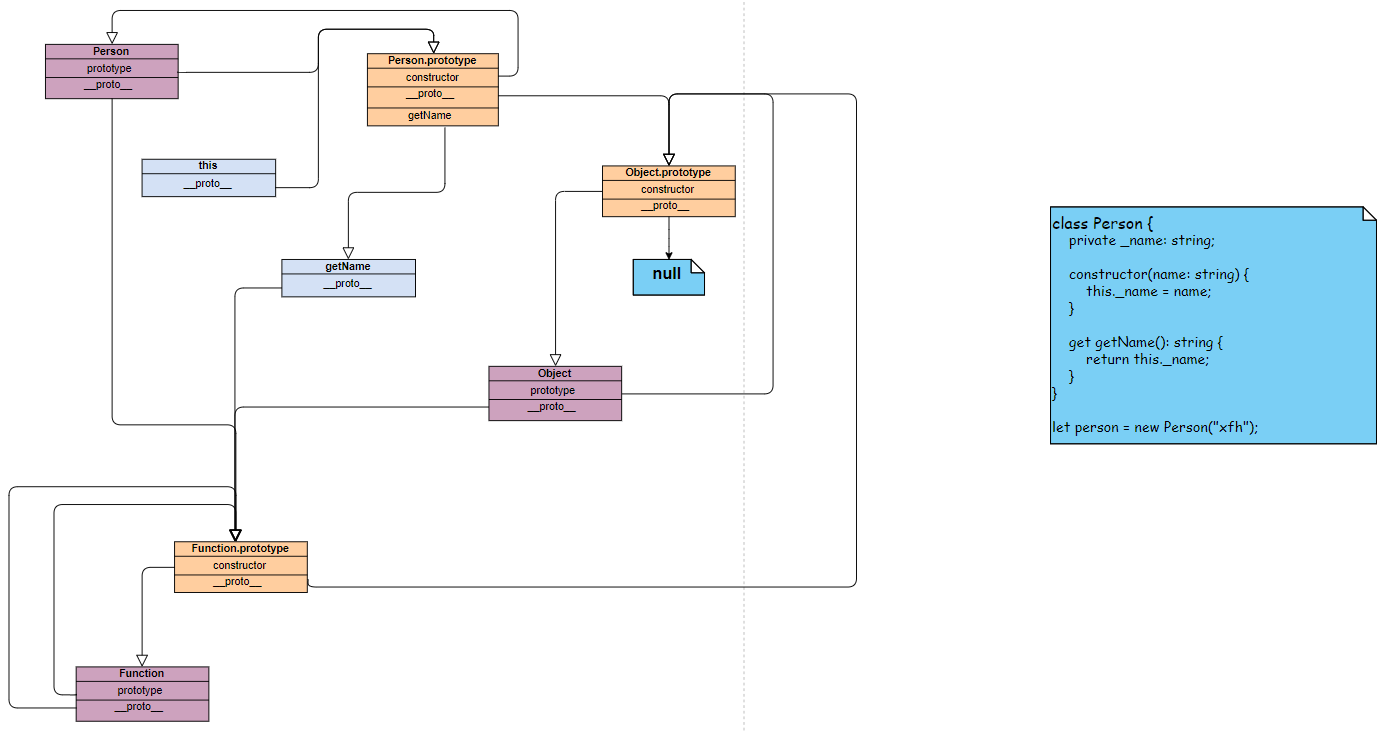实现JavaScript继承
原型 & 原型链
原型用于对象属性的查找。画出下面代码中的原型链图示:
class Person { private _name: string; constructor(name: string) { this._name = name; } get getName(): string { return this._name; } } let person = new Person("xfh");

图中,__proto__表示实例的原型对象,prototype表示构造函数的原型对象。不再推荐使用__proto__,将来可能会被废弃,可使用Object.getPrototypeOf()来获取对象的原型。
关于原型/链,记住以下几点:
-
原型链的终点是null,从这个角度,可以将null看作所有Object的基类
-
实例的原型对象和它构造函数的原型对象是同一个对象(比较拗口)
-
所有的函数(包括构造函数及Function自身)都是Function的实例
-
函数是普通的对象,只是具备了可调用(callable)功能 ,想到了Python中的类装饰器,也是具备了可调用功能的普通类
-
所有的对象终归是Object的实例,即Object位于所有对象的原型链上
// 原型链的终点是null Object.getPrototypeOf(Object.prototype)===null // true Object.prototype instanceof Object // false // 实例和构造函数的原型对象是同一个对象 Object.getPrototypeOf(Function)===Function.prototype // true // 所有的函数(包括构造函数及Function自身)都是Function的实例 Function instanceof Function // true,Function是自己的实例 Object instanceof Function // true,构造函数是Function的实例 // 所有的对象终归是Object的实例,即Object位于所有对象的原型链上 Function.prototype instanceof Object // true Function instanceof Object // true Object instanceof Object // true
typeof操作符与instanceof`关键字的区别如下:
Keep in mind the only valuable purpose of
typeofoperator usage is checking the Data Type. If we wish to check any Structural Type derived from Object it is pointless to usetypeoffor that, as we will always receive"object". The indeed proper way to check what sort of Object we are using isinstanceofkeyword. But even in that case there might be misconceptions.
实现继承
/** * 从基类继承成员 * @param child 子类构造函数或实例 * @param base 基类构造函数或实例 */ function inheritMembers(child, base) { let ignorePropertyNames = ["name", "caller", "prototype", "__proto__", "length", "arguments"]; let propertyNames = Object.getOwnPropertyNames(base); for (let propertyName of propertyNames) { if (ignorePropertyNames.includes(propertyName)) { continue; } let descriptor = Object.getOwnPropertyDescriptor(base, propertyName); if (!descriptor) { continue; } Object.defineProperty(child, propertyName, descriptor); } } /** * 从基类继承原型及静态成员 * @param thisCtor 子类构造函数 * @param baseCtor 基类构造函数 */ function inheritSharedMembers(thisCtor, baseCtor) { if (typeof thisCtor !== "function" || typeof baseCtor !== "function") { throw TypeError("参数必须是函数:thisCtor,baseCtor"); } // 继承原型成员 thisCtor.prototype = Object.create(baseCtor.prototype); thisCtor.prototype.constructor = thisCtor; // 继承静态成员 inheritMembers(thisCtor, baseCtor); } /** * 调用子类及父类构造函数创建子类实例,并继承父类实例成员(这也是调用父类构造函数的原因) * @param thisInstance 子类实例 * @param baseInstance 父类实例 */ function createInstance(thisInstance, baseInstance) { inheritMembers(thisInstance, baseInstance); return thisInstance; } // 构造函数 function Animal(tag) { // 实例属性 this.tag = tag; } // 静态方法,需通过构造函数来调用 Animal.bark = function () { console.log("static func, this= " + this + ", typeof this=" + typeof this); }; // 原型方法,需通过实例来调用 Animal.prototype.getInfo = function () { console.log("property func, tag:" + this.tag); }; function Dog(name = null) { this.name = name ?? "default"; } // 添加子类原型方法 Dog.prototype.dogBark = function () { console.log("dog bark"); }; // 继承父类原型及静态成员 inheritSharedMembers(Dog, Animal); var animal = new Animal("animal"); Animal.bark(); // TypeError: animal.bark is not a function // animal.bark(); animal.getInfo(); // property getInfo not exist on type 'typeof Animal' // Animal.getInfo(); let dog = createInstance(new Dog("dog"), new Animal("dog")); dog.getInfo(); dog.dogBark(); Dog.bark(); console.log(dog.name);
最后使用v4.1.3版本的TS,编译为ES5版本的JS,看看TS背后是如何实现继承的:
class Person { name: string; age: number; constructor(name: string, age: number) { // 只能在构造函数中使用this关键字 this.name = name; this.age = age; } // 静态方法中调用本类中的另一个静态方法时,可以使用this.methodName的形式 // 在外部调用时只能类名.方法名的形式,所以此时方法内部,this是指向构造函数的 // 即,this.methodName等价于类名.方法名 static static_method() { // 这里this指向Person类,typeof this=function // 可以看出class Person本质上是构造函数,class只是语法糖 console.log(`static method, this=${this}, typeof this=${typeof this}`); } } // 使用extends继承 class Chinese extends Person { constructor(name: string, age: number) { // 必须调用父类构造函数,且需要在子类构造函数使用this关键字之前调用,否则会产生错误: // A 'super' call must be the first statement in the constructor when a class contains initialized properties or has parameter properties. super(name, age); } sayHello() { console.log(`I'm ${this.name}, I'm ${this.age} years old.`) } } let cn = new Chinese('xfh', 26); cn.sayHello(); Chinese.static_method();
编译后代码如下:
"use strict"; var __extends = (this && this.__extends) || (function () { var extendStatics = function (d, b) { extendStatics = Object.setPrototypeOf || ({ __proto__: [] } instanceof Array && function (d, b) { d.__proto__ = b; }) || function (d, b) { for (var p in b) if (Object.prototype.hasOwnProperty.call(b, p)) d[p] = b[p]; }; return extendStatics(d, b); }; return function (d, b) { extendStatics(d, b); function __() { this.constructor = d; } d.prototype = b === null ? Object.create(b) : (__.prototype = b.prototype, new __()); }; })(); var Person = /** @class */ (function () { function Person(name, age) { // 只能在构造函数中使用this关键字 this.name = name; this.age = age; } // 静态方法中调用本类中的另一个静态方法时,可以使用this.methodName的形式 // 在外部调用时只能类名.方法名的形式,所以此时方法内部,this是指向构造函数的 // 即,this.methodName等价于类名.方法名 Person.static_method = function () { // 这里this指向Person类,typeof this=function // 可以看出class Person本质上是构造函数,class只是语法糖 console.log("static method, this=" + this + ", typeof this=" + typeof this); }; return Person; }()); // 使用extends继承 var Chinese = /** @class */ (function (_super) { __extends(Chinese, _super); function Chinese(name, age) { // 必须调用父类构造函数,且需要在子类构造函数使用this关键字之前调用,否则会产生错误: // A 'super' call must be the first statement in the constructor when a class contains initialized properties or has parameter properties. return _super.call(this, name, age) || this; } Chinese.prototype.sayHello = function () { console.log("I'm " + this.name + ", I'm " + this.age + " years old."); }; return Chinese; }(Person)); var cn = new Chinese('xfh', 26); cn.sayHello(); Chinese.static_method();
推荐阅读
JavaScript data types and data structures


 浙公网安备 33010602011771号
浙公网安备 33010602011771号